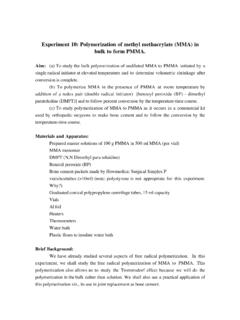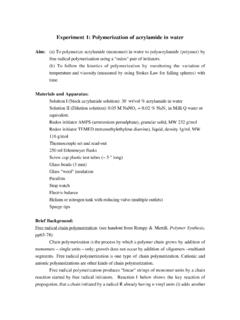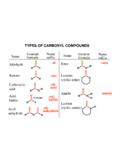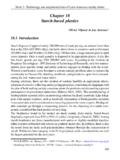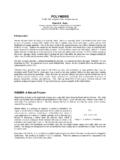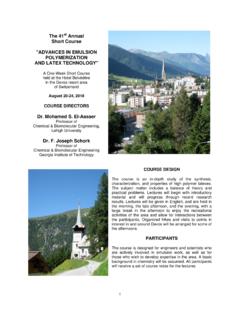Transcription of 6,10 Nylon of polymerization Interfacial 6: Experiment
1 Experiment 6: Interfacial polymerization of Nylon 6,10 Aim: (a) To synthesize unsupported membranes of Nylon 6,10 by unstirred Interfacial step polymerization of hexamethylene diamine (HMDA) and sebacoyl chloride. To observe the quality of the Nylon film produced as a function of the rate of removal and of the concentrations of diamine and diacid chloride in their respective phases. (b) To study the tensile properties of the synthesized collapsed film and compare it to the tensile properties of Nylon tire cord. (c) To synthesize supported membranes of Nylon 6,10 on hydrophilic Millipore membranes. Materials and Apparatus: Sebacoyl chloride (tested for degradation) Dichloromethane Hexamethylene diamine Na2CO3 in water Methanol/Ethanol Yellow food dye Nylon undrawn tire cord Spatula Forceps Vessel (1-2 l) String Beakers 250 ml (narrow diameter preferred) 25 mm microns Millipore membrane Petri dishes Variable speed lab mixer (check for stability of rotation rate at slow speeds before using.)
2 Use Variacs if necessary) Stopwatch Dial micrometer ( ") Weighing machine Hand held force gauge (max. load of 1000g or lbs) (2)(2)Brief Background: Step polymerization : (see handouts from Rempp & Merrill, Polymer Synthesis, pp35-40 and 50-57.) As we noted before, the two main types of polymerization are chain and step polymerization . In chain polymerization , only the monomer can attach to the growing chain. However, in step polymerization the chain can grow by addition of monomers, oligomers and other polymer chains. For example, a chain consisting of four units could be formed by two routes - a) the addition of a monomer to a trimer (chain with three units) or b) the reaction of two dimers (chain with two units).
3 Note that in chain polymerization only the first route would occur. Step polymerization involves the reaction of bifunctional monomers ( , the two ends of the monomer each have a reactive functional group). Often in notes and texts, the functional groups are generically written as A and B; these two groups react to form a new group, -C- . Some steps of the reaction are illustrated below for the case where two different monomers are involved: A A+B B A B (1) A A A A (2)B + AFor polyesters, this reaction might be: HO R O OC O HO R OH +HOOC R' COOH R' COH Step polymerization can take place even if there is only one monomer but then the two functional groups on the monomer have to be different and reactive.
4 Schematically: A B+A B A B (3) A B A B (4)B + A For example O OO HO ROC R' COH + HOOC R' COOH HOOC R' CO ROC R' COH Note that a water molecule is produced as a by-product in each step. Step polymerizations where a small molecule (like water or HCl) is produced during reaction is called polycondensation. Step Growth polymerization Polyamides (Nylons):Polyamides are polymers where the monomer units are connected together by amide groups ( -C(=O)-NH- ). Two generic schemes for polyamide synthesis include condensation of diacid and diamine monomers in the bulk state or at high concentrations. The first illustrated in Equation 8.
5 Equation (8) OO H2 NCH2 NH2 + HOC CH2 COH 68 OO NH CH2 COCH2 NH C 86 n The above reaction creates H2O as a byproduct, producing (n-1) moles of water for n moles of repeat units. It turns out that the reaction above is at or near equilibrium at low to moderate temperatures (Keq is around one to ten in value). To drive toward the product, high temperature and very effective water byproduct removal must be achieved for high polymer conversion. A second approach is to use the much more reactive acid chloride group in place of the acid. The reaction of diamines with diacid chlorides have equilibrium constants that are about two orders of magnitude higher than those of diamines with diacids.
6 The reaction greatly favors the production of amide product, and the reaction kinetics is extremely fast: Equation (9) O O H2 NCH2 NH2 6 + ClC CH2 CCl 8 OO NH CH2 COCH2 NH C 86 n Here (n-1) moles of HCl is created as a byproduct. HCl can be neutralized by the presence of weak base in the reaction solvent. This second reaction is extremely rapid, and rather difficult to control in moderate to high monomer concentrations. It is possible to accomplish a polymerization of diamine and diacid chloride in a good solvent for both monomers. On the other hand, the reaction is very fast, irreversible, and highly exothermic. The concentrations must be kept low, and the temperature must also be controlled, often below room temperature, to prevent overheating and side reactions.
7 The solvent must be a good one not only for the monomers, but for the resulting polymer, to achieve high molecular weight. Interfacial polymerization : (see handout from Rempp & Merrill, Polymer Synthesis, pp280-287). A rapid, but more controlled approach is to take advantage of the fast kinetics of the polymerization of diamines and diacid chlorides at the interface between two immiscible phases. Interfacial polymerization involves the reaction of monomer A dissolved in an organic phase with a monomer B dissolved in an inorganic phase at the interface between the two non-miscible phases. Interfacial polymerization can be of two types.
8 In one case, there are two separate macroscopic layers in contact with each other. This is called unstirred Interfacial polymerization . This is what we are going to study in this Experiment . Unstirred Interfacial polymerization is used to produce membranes and to create polymer by continuous removal in a single rope. The other case is one where one phase is dispersed as tiny droplets in the other (continuous) phase by using high speed stirring. This is called stirred Interfacial polymerization . Stirred Interfacial polymerization is used to produce tiny microcapsules (hollow inside) and microspheres (not hollow) for various applications like controlled release of drugs and pesticides.
9 Unstirred Interfacial polymerization of Nylon 6,10: We shall study the reaction of 1,6 diamino hexane (HMDA) with diacid chloride (sebacoyl dichloride-SC) to form Nylon 6,10 as shown in reaction (9). The polymer will form at the interface between a layer of diamino hexane dissolved in water (aqueous phase) and a layer of diacid chloride dissolved in dichloromethane-DCM (organic phase). The aqueous phase also contains sodium bicarbonate as a getter for HCl (see reaction 10). 2 HCl + Na2CO3 > 2 NaCl + H2O+CO2 (10) The denser organic phase forms the lower phase (chlorinated solvents are used, which are denser than water) while the aqueous phase will be carefully poured on top of the organic phase.
10 Interfacial polymerization occurs instantly forming a thin film of solid Nylon 6,10 at the interface. The film at the interface stops further reaction by preventing the monomers from meeting each other (actually some monomers do reach other by diffusion through the film but this is so slow that the film appears to have stopped growing). The hydrochloric acid is rapidly neutralized by the carbonate in the aqueous phase. If the Nylon film is pulled up, out of the interface, new film is formed continuously. In contrast to reaction in the bulk (discussed before while discussing reaction 8), there is no need to control of the stoichiometric ratio in this Experiment .
